Physical Address
304 North Cardinal St.
Dorchester Center, MA 02124
Fibrous connective tissue consists principally of fibroblasts and an extracellular matrix (ECM) containing fibrillary structures (collagen, elastin) and nonfibrillary ECM, or ground substance. Dense fibrous connective tissue, such as that found in tendons, aponeuroses, and ligaments, is composed predominantly of fibrillar collagen, whereas loose fibrous connective tissue contains a relative abundance of nonfibrillary ground substance.
Fibroblasts are the predominant cells in fibrous connective tissue. These cells are spindle shaped with pale-staining, smooth-contoured oval nuclei, one or two minute nucleoli, and eosinophilic to basophilic cytoplasm, depending on the state of synthetic activity. The cytoplasmic borders are usually indistinct, although fibroblasts deposited in a rich myxoid stroma tend to assume a more stellate shape with multiple slender cytoplasmic extensions. Ultrastructurally, fibroblasts typically contain numerous, often dilated, cisternae of rough endoplasmic reticulum (RER), a large Golgi complex associated with small vesicles filled with granular or flocculent material, scattered mitochondria typically in a perinuclear location, many free ribosomes, occasional fat droplets, and slender microfilaments. Fibroblasts are responsible for the intracellular assembly of various extracellular fibrillary and nonfibrillary products such as procollagen, protoelastin, and glycosaminoglycans, which form the ground substance of connective tissue.
Myofibroblasts share morphologic features with fibroblasts and smooth muscle cells. These cells are found in variable proportions in diverse processes, including responses to injury and repair phenomena, in quasineoplastic proliferative conditions, as part of the stromal response to neoplasia, and in a variety of benign and malignant neoplasms composed, at least in part, of myofibroblasts. Ultrastructurally, myofibroblasts are characterized by indented nuclei with numerous long, cytoplasmic extensions. In the cytoplasm, bundles of microfilaments, which are usually arranged parallel to the long axis of the cell, are present with interspersed dense bodies. Subplasmalemmal plaques and pinocytotic vesicles are also numerous. The cells are partly enveloped by a basal lamina. The fibronexus, transmembrane complexes of intracellular microfilaments in continuity with the ECM, is also characteristic of this cell type. Immunohistochemically, myofibroblasts may have a variable phenotype, including those that express (1) vimentin (V type) only; (2) vimentin, smooth muscle actin, and desmin (VAD type); (3) vimentin and smooth muscle actin (VA type); and (4) vimentin and desmin (VD type) ( Fig. 7.1 ). These immunophenotypes differ depending on the type of myofibroblastic proliferation encountered.
Collagen is the main product of fibroblasts and the major constituent of ECM. Up to 11 closely related but genetically distinct types of collagen are found in connective tissue, differing in the amino acid composition of their α chains. Collagen chain polypeptides are synthesized on the ribosomes of the RER of fibroblasts and a variety of other cell types. These precursor pro-α chains are then transported to the Golgi apparatus, where they coil into a triple helix, forming procollagens. After release from the Golgi apparatus, they are discharged into the pericellular matrix by exocytosis. Following enzymatic cleavage by procollagen peptidases, tropocollagen filaments spontaneously aggregate in a staggered fashion, resulting in the formation of typical banded collagen fibrils with 64-nm periodicity. Long-spacing collagen with 240-nm periodicity is occasionally encountered in both normal and neoplastic tissues.
Type I collagen is ubiquitous and consists of parallel arrays of thick, closely packed banded fibrils. This type of collagen is found in the dermis, tendons, ligaments, bone, fascia, corneal tissue, and dentin. It is strongly birefringent and consists of two α 1 chains and one α 2 chain entwined in a helical configuration. Type II collagen , synthesized by chondroblasts, is found in ECM of cartilage and in the notochord, nucleus pulposus, embryonic cornea, and vitreous body of the eye. Type III collagen is often associated with type I collagen, characteristically in loose connective tissue, including the dermis, blood vessel walls, and various glands and parenchymal organs. Type IV collagen is the major component of basal lamina. This collagen type is nonfibrillar and does not undergo any changes after secretion from the cell. Type V collagen is primarily found in blood vessels and smooth muscle tissue. Other types of collagen (types VII, VIII, IX) are less common and less well defined.
Reticular fibers form a delicate network of fibers that have the same cross-banding as collagen (67 nm) but differ from collagen fibers by their small size (approximately 50 nm in diameter) and their argyrophilia. Reticular fibers are composed of mainly type III collagen. Amianthoid fibers are fused, abnormally thick collagen fibers with a typical periodicity but measuring up to 1000 nm in diameter.
Elastic fibers are usually closely associated with collagen fibers and are important components of ECM of the dermis, large vessels, and internal organs (e.g., heart, lung). Light microscopy shows slender, branching, highly refractile, weakly birefringent structures that stain with Weigert resorcin-fuchsin, Verhoeff, and aldehyde-fuchsin. Ultrastructurally, they have no cross-striations or banding. Elastic fibers are composed of two distinct components: elastin , a large amorphous homogeneous or finely granular structure of low electron density, and peripherally located microfibrils that are 10 to 12 nm in length. Elastin, the main component of elastic fibers, is synthesized and secreted as tropoelastin by fibroblasts; it typically contains large amounts of glycine, alanine, valine, and desmosine and minimal hydroxyproline. It is resistant to trypsin digestion but is hydrolyzed by elastase. Altered elastic fibers are found in a variety of heritable and acquired diseases and in ECM of both benign and malignant neoplasms.
The ECM is also partly composed of glycoproteins , including fibronectin and laminin. Fibronectin is a high-molecular-weight glycoprotein synthesized by fibroblasts and a variety of other cells. It affects cell-to-cell cohesion and the interaction between cells and ECM, serving as a molecular glue. Laminin is a large glycoprotein distributed throughout the lamina lucida and lamina densa of the basement membrane.
Glycosaminoglycans (GAGs, mucopolysaccharides ) form the ground substance of connective tissue. GAGs are intimately associated with fibroblasts and collagen fibers, play an important role in salt and water distribution, and serve as a link in various cellular interactions. These substances are synthesized in fibroblasts or chondroblasts, where they are polymerized and sulfated in the Golgi complex. Chemically, GAGs are linear polysaccharide chains of hexosamines (glycosamino-) and various sugars (-glycans) that are bound to proteins, with the exception of hyaluronic acid. They have a high molecular weight, are negatively charged, and are capable of binding large amounts of fluids. GAGs do not stain with hematoxylin-eosin but stain well with Alcian blue, colloidal iron, and toluidine blue.
One of the most important GAGs is hyaluronic acid , a nonsulfated disaccharide chain composed of glucosamine and glucuronic acid. This substance is abundant in fibrous connective tissue and is the major component of synovial fluid. Histochemically, it is depolymerized and decolorized by hyaluronidase. Chondroitin sulfates (types 4 and 6) combine galactosamine and glucuronic acid, and these substances predominate in hyaline and elastic cartilage, nucleus pulposus, and intervertebral disks. Other GAGs are dermatan sulfate and heparin sulfate. Dermatan sulfate is found predominantly in the dermis, tendons, and ligaments, whereas heparin sulfate is found in various structures rich in reticular fibers.
On the basis of distinct clinical and histologic features, there are four categories of fibroblastic/myofibroblastic lesions: (1) pseudosarcomatous lesions, of which nodular fasciitis is the prototype; (2) fibromatoses, locally recurring but nonmetastasizing lesions; (3) sarcomas with fibroblastic and/or myofibroblastic features that range in behavior from low to high grade; and (4) fibroblastic/myofibroblastic proliferations of infancy and childhood. The fourth category is separate because most fibroblastic/myofibroblastic lesions that occur during the first years of life have characteristic features that differ from those in older children and adults (see Chapter 8 ). This chapter also includes the superficial fibromatoses (penile, palmar and plantar fibromatoses, and knuckle pads), whereas the deep fibromatoses are fully discussed in Chapter 9 .
Nodular fasciitis is a pseudosarcomatous, self-limited process composed of fibroblasts and myofibroblasts. Despite heightened awareness of this entity over the past 30 years and innumerable soft tissue seminars, nodular fasciitis is still among the most common benign mesenchymal lesions misdiagnosed as a sarcoma, because of its characteristic rapid growth, rich cellularity, and mitotic activity. It is one of the most common soft tissue lesions and occurs more often than any other tumor or tumorlike lesion of fibrous tissue.
Histologically, nodular fasciitis closely resembles organizing granulation tissue, an observation historically used to support a reactive etiology, possibly resulting from trauma, inconspicuous or otherwise. Morphologic variants of nodular fasciitis include intravascular, cranial, and ossifying fasciitis (described in later sections), all of which have overlapping histologic features unified by a proliferation of cytologically bland fibroblasts and myofibroblasts. It is differences in clinical, gross, and light microscopic features that warrant retention of these specific designations, although recognition as a benign process is much more important than the ability to apply a precise name.
Some patients provide a history of a rapidly growing mass or nodule that has been present for only 1 to 2 weeks. About half report associated soreness, tenderness, or slight pain. Numbness, paresthesia, or shooting pain is rare and develops only when the rapidly growing nodule exerts pressure on a peripheral nerve. Virtually all lesions are solitary.
Although nodular fasciitis may occur in patients of any age, it is most common in adults 20 to 40 years old ( Fig. 7.2 ). Males and females are about equally affected. Most of the lesions grow rapidly and have a preoperative duration of 1 month or less. Although nodular fasciitis may occur virtually anywhere on the body, there is a distinct predilection for certain sites, the most common being the upper extremities, especially the volar aspect of the forearm, followed by the trunk, particularly the chest wall and back. Nodular fasciitis in the head and neck is next in frequency and is the most common site in infants and children. It is less common in the lower extremities and infrequent in the hands and feet. This lesion has also been reported in a variety of unusual locations, including the parotid gland ( Fig. 7.3 ), external ear, oral cavity, breast, and lymph node capsule ( Fig. 7.4 ).
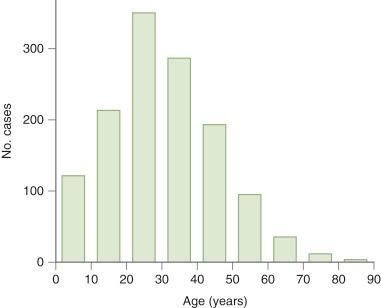
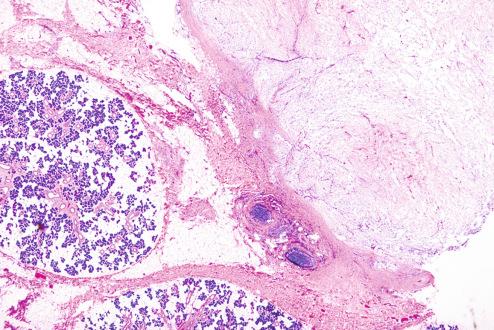

The gross appearance of nodular fasciitis is highly dependent on the relative amounts of myxoid and fibrous stroma and the cellularity of the lesion. Most are relatively well-circumscribed but nonencapsulated lesions, although some, particularly those centered on the deep fascia, are poorly circumscribed and appear to infiltrate the surrounding soft tissues. Most are 2 cm or less in greatest dimension when excised. Although occasionally as large as 10 cm at excision, the diagnosis of nodular fasciitis should always be made with considerable trepidation in this setting. Intramuscular lesions tend to be slightly larger than those found in the subcutaneous tissue.
The appearance of the cut surface depends on the relative amounts of myxoid and collagenous material. Those with a predominantly myxoid matrix are soft and gelatinous and grossly resemble other myxoid soft tissue lesions such as myxoma, ganglion, or benign peripheral nerve sheath tumors. Those with a pronounced collagenous stroma are firm and resemble other fibrous lesions such as fibromatosis or fibrosarcoma. Although extravasated erythrocytes are a frequent microscopic feature, these lesions are rarely grossly hemorrhagic.
Nodular fasciitis can be grouped into three major subtypes, based on their relation with the fascia. The subcutaneous type, the most common form of nodular fasciitis, is a well-circumscribed spherical nodule attached to the fascia but growing upward into the subcutis ( Figs. 7.5 and 7.6 ). The intramuscular type is superficially attached to the fascia; it grows as an ovoid intramuscular mass and is often larger than the subcutaneous type. The fascial type, which is centered along the fascia, is less well circumscribed than the other forms, growing along the interlobular septa of the subcutaneous fat, resulting in a raylike or stellate growth pattern. Rare examples of nodular fasciitis arise in the dermis.
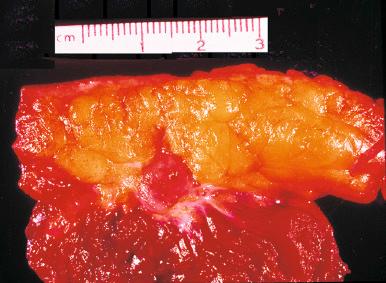
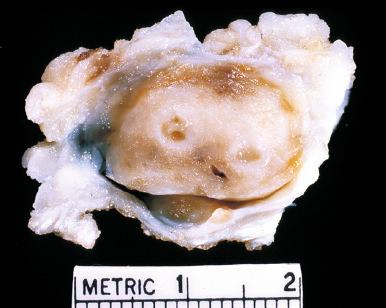
All cases of nodular fasciitis, regardless of whether they are predominantly fibrous or myxoid, are composed of plump, immature-appearing fibroblasts and myofibroblasts that closely resemble the fibroblasts found in tissue culture or granulation tissue ( Fig. 7.7 ). In general, the cells vary little in size and shape and have oval, pale-staining nuclei with prominent nucleoli ( Fig. 7.8 ). Mitotic figures are fairly common, but atypical mitoses are virtually never seen.
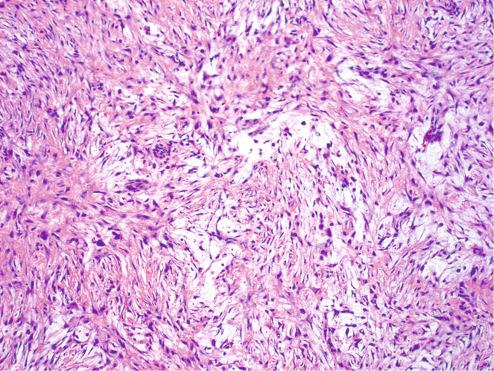
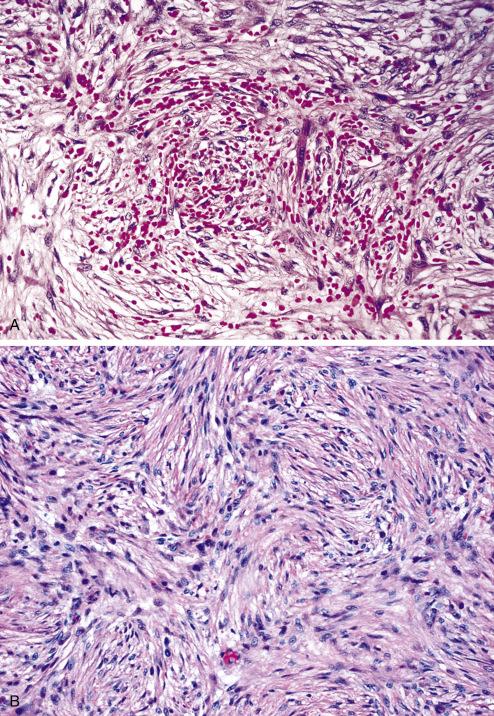
Characteristically, the cells are arranged in short, irregular bundles and fascicles and are accompanied by small amounts of mature birefringent collagen. The intervening matrix is rich in mucopolysaccharides that stain readily with Alcian blue preparation and are depolymerized by hyaluronidase. The abundance of ground substance is responsible for the characteristic loosely textured, feathery pattern of nodular fasciitis; there are also cellular forms with only small amounts of interstitial myxoid material. Intermixed with the spindled cells are scattered lymphoid cells and erythrocytes and, in the more central portion of the lesion, a small number of lipid macrophages and multinucleated giant cells. Occasionally, there are associated areas of microhemorrhage, but siderophages are rare ( Fig. 7.9 ).
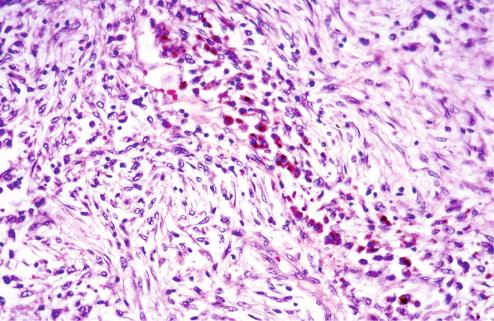
There are minor variations in the histologic picture. In some cases the intramuscular form of nodular fasciitis contains residual atrophic muscle fibers and muscle giant cells, although this feature is much less pronounced in nodular fasciitis than in deep fibromatoses. The fascial type of nodular fasciitis may have cells arranged in a radial fashion around a central, poorly cellular, edematous area containing a mixture of mucoid material and fibrin.
There is a close correlation between the microscopic picture and the preoperative duration of the lesion. Lesions of short duration tend to have a predominantly myxoid appearance ( Fig. 7.10A and B ), whereas those of longer duration are characterized by hyaline fibrosis ( Fig. 7.10C and D ), tissue shrinkage, and formation of minute fluid-filled spaces, or microcysts, a sequence closely paralleling the cicatrization of granulation tissue. In cases of long duration, the microcysts sometimes fuse and form a large, centrally located cystic space ( cystic nodular fasciitis ).
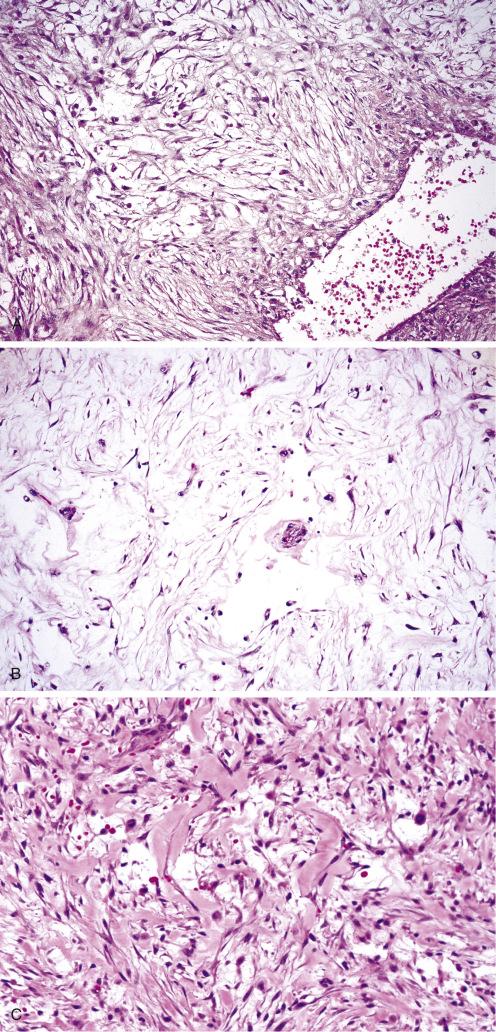
On rare occasions, a nodular fasciitis-like lesion has metaplastic bone, a condition described as ossifying fasciitis or fasciitis ossificans and, when arising from the periosteum, as parosteal fasciitis ( Fig. 7.11 ). Most of these lesions have features of both nodular fasciitis and myositis ossificans , but they may be less well circumscribed than nodular fasciitis and lack the zonal maturation of myositis ossificans. Occasionally, small foci of metaplastic bone are also found in morphologically typical nodular fasciitis. Panniculitis ossificans and fibroosseous pseudotumor of the digits are closely related lesions that have a more irregular pattern and are somewhat akin to myositis ossificans. Rare cases of proliferative fasciitis, proliferative myositis, and cranial fasciitis may also contain foci of metaplastic bone.
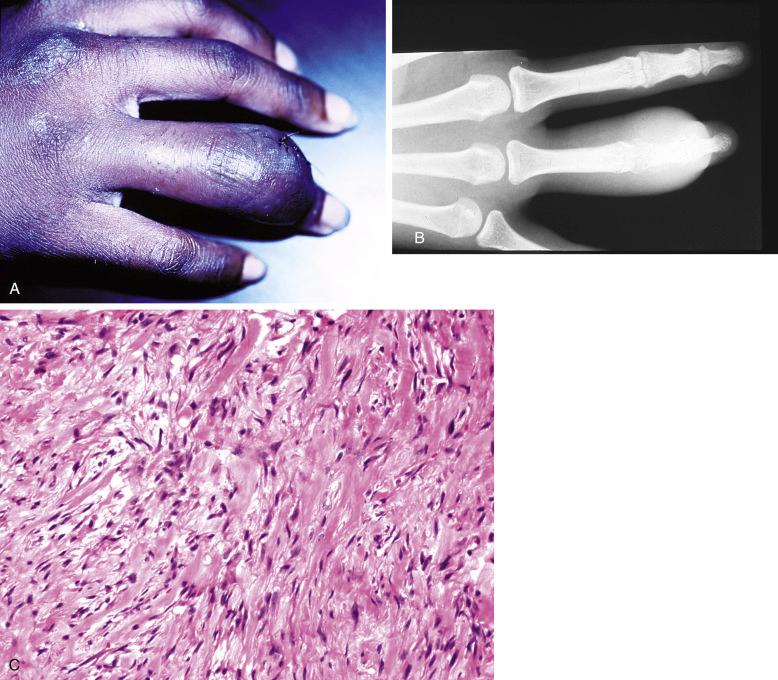
Intravascular fasciitis is a rare variant of nodular fasciitis characterized by the involvement of small or medium-size veins or arteries. Males and females are about equally affected, and most patients are young; very few patients are 30 years or older. The typical presentation is that of a slowly growing, painless, solitary subcutaneous mass usually 2 cm or smaller. The upper extremity is the most common site, followed closely by the head and neck. Less common sites include the trunk, lower extremities, and oral cavity. Grossly, the lesions may be round or oval, or they may be elongated, multinodular, or plexiform, particularly those that grow as a predominantly intravascular mass ( Fig. 7.12 ). Small to medium-size veins are most commonly affected, but some lesions involve arteries alone or are seen in conjunction with venous structures. In most cases, there is involvement of the intima, media, adventitia, and perivascular soft tissue, frequently with a predominantly extravascular component, although some grow as an intraluminal polypoid mass ( Fig. 7.13 ). The association with a vessel may be obscured by the proliferation, so special stains (e.g., Movat) are required to highlight the involved vessel.
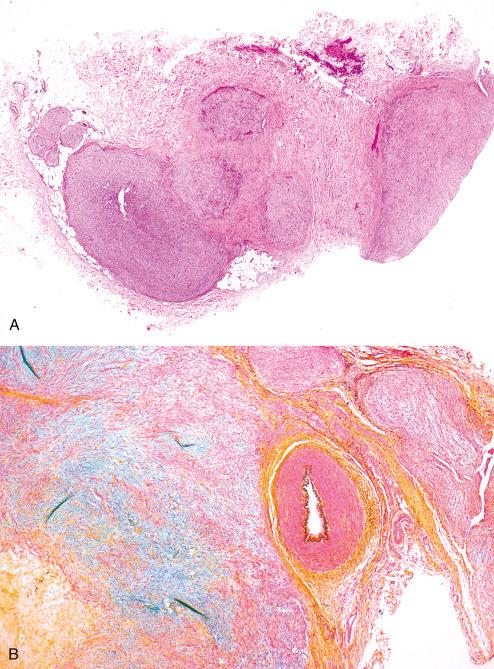
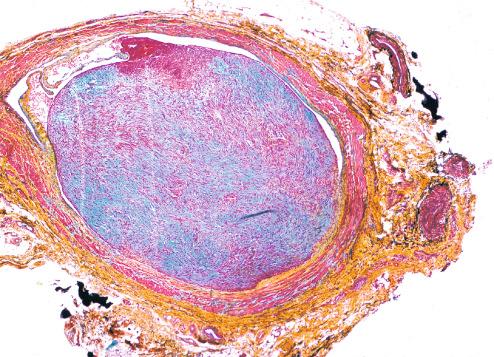
Histologically, the intravascular growth closely resembles nodular fasciitis, but it has a less prominent mucoid matrix and a conspicuous number of osteoclast-like giant cells, resembling a benign fibrous histiocytoma or a giant cell tumor of soft parts ( Figs. 7.14 and 7.15 ). Rare examples are predominantly myxoid. Clefts are often present in areas where the proliferation has separated from the vessel wall. Because of the vessel involvement, this lesion may be confused with an organizing thrombus, intravascular capillary hemangioma, intravascular leiomyoma, or a sarcoma; 6 of 15 of the original lesions reported were initially confused with a sarcoma. Despite the intravascular growth, there is no evidence of aggressive clinical behavior, recurrence, or metastasis.
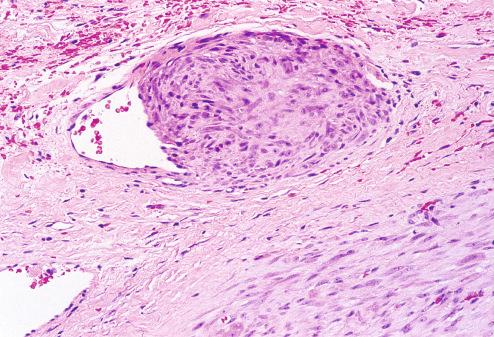
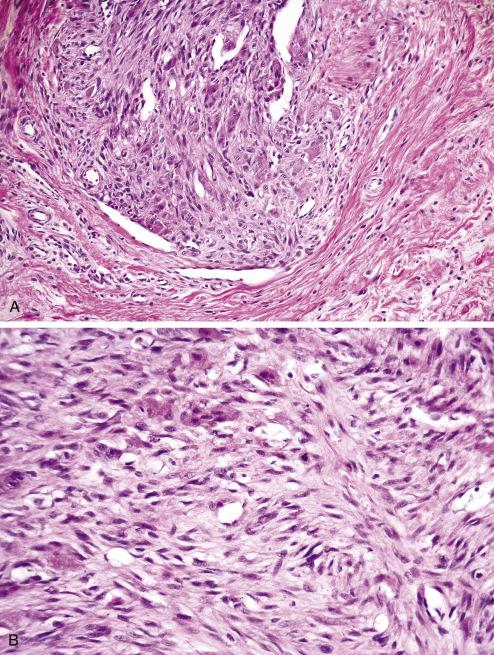
Cranial fasciitis is a rapidly growing myofibroblastic proliferation that occurs chiefly, but not exclusively, in infants during the first year of life and involves the soft tissues of the scalp and the underlying skull. It usually erodes the outer table of the cranium and frequently also penetrates the inner table, infiltrating the dura and sometimes even the leptomeninges. Radiographically, those that involve the underlying cranium create a lytic defect, often with a sclerotic rim ( Fig. 7.16 ). Histologically, cranial fasciitis exhibits the broad morphologic spectrum of nodular fasciitis; it is composed of a proliferation of fibroblasts and myofibroblasts deposited in a variably myxoid and hyalinized matrix, occasionally with foci of osseous metaplasia. The circumscription and the prominent myxoid matrix help distinguish the lesion from infantile fibromatosis or myofibromatosis.
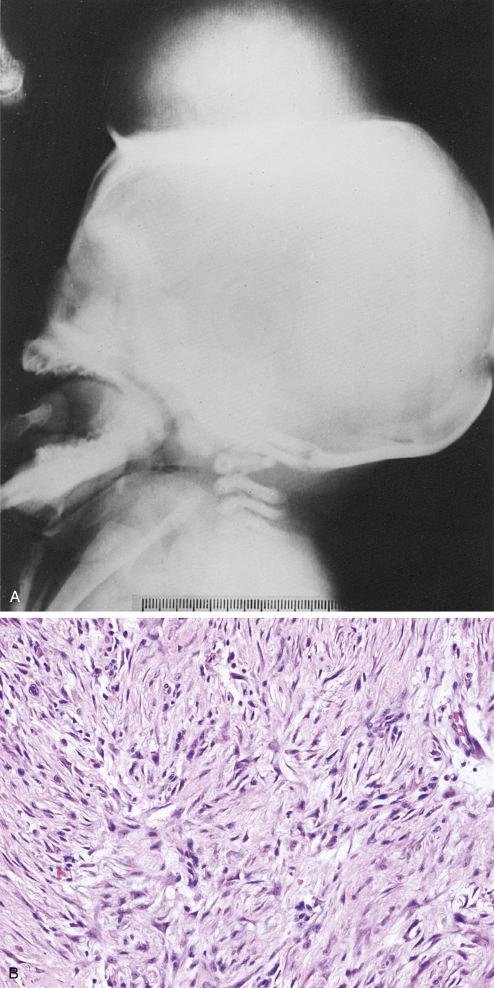
Birth trauma may play a role in the development of cranial fasciitis; some affected children have been delivered by forceps. Interestingly, Rakheja et al. reported a case of cranial fasciitis arising in a child with familial adenomatous polyposis (FAP); this lesion showed strong and diffuse nuclear immunoreactivity for β-catenin, suggesting dysregulation of the Wnt/β-catenin pathway in a subset of cases. Another case of cranial fasciitis was associated with a deep fibromatosis, with both lesions showing staining for β-catenin. Rare cases also arise at the site of a prior craniotomy.
There is no relation between cranial fasciitis and the head banger’s tumor , a fibrosing lesion of the forehead with pigmentation of the overlying skin. Also, there is no association with an inherited fibrosing lesion of the scalp ( cutis verticis gyrata ) that occurs in adults and is associated with clubbing of the digits, enlargement of the distal extremities, and periosteal bone formation (pachydermoperiostosis).
As one would expect in a lesion composed of myofibroblasts, most cells of nodular, ossifying, intravascular, and cranial fasciitis stain for smooth muscle actin and muscle-specific actin ( Fig. 7.17 ). Desmin is rarely expressed by the constituent cells; of the 53 cases stained by Montgomery and Meis, none expressed this antigen. h-Caldesmon has been purported to be a useful marker in distinguishing smooth muscle from myofibroblastic proliferations, as this antigen is typically expressed in smooth muscle tumors but is absent in nodular fasciitis. In small biopsy specimens, nodular fasciitis may be difficult to distinguish from a fibromatosis. β-Catenin may be useful in this regard because the antigen is consistently expressed in an aberrant nuclear pattern in most cases of fibromatoses and is absent in the myofibroblasts of nodular fasciitis. Immunostains for keratin and S-100 protein are consistently negative.
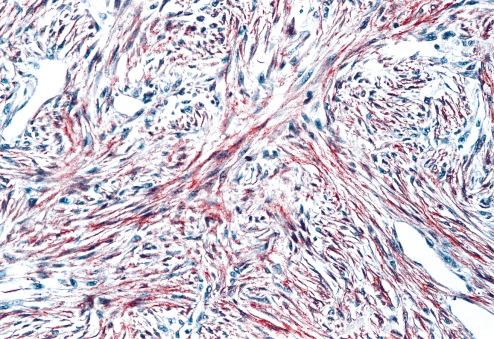
In a study from Mayo Clinic in 2011, 44 of 48 (92%) cases of nodular fasciitis were found to have rearrangements of USP6 (located at 17p13). Further analysis identified MYH9 (22q13.1) as the translocation partner, a fusion that was not identified in any of the control tissues or tumors. The authors proposed the fascinating concept of “transient neoplasia,” given that this was the first known example of a self-limited process characterized by a recurrent gene fusion. Many subsequent studies have confirmed the consistent involvement of the USP6 gene in this lesion, although not all have MYH9 as the fusion partner. The Jak1-STAT3 signaling pathway has been implicated as an effector of this proliferation. USP6 rearrangements are also characteristically present in aneurysmal bone cyst.
Nodular fasciitis may be confused with numerous benign and malignant mesenchymal lesions, and the differential diagnosis depends on the relative amounts of myxoid and fibrous stroma and the cellularity of the lesion in question. As previously mentioned, nodular fasciitis remains the most common benign mesenchymal lesion misdiagnosed as a sarcoma. Therefore, many cases of nodular fasciitis have been treated by unnecessary and excessive radical surgery.
Although nodular fasciitis and myxoma may display a prominent myxoid matrix, myxoma is readily recognized by its paucity of cells and poor vascularization. Myxomas also lack the zonal organization and regional heterogeneity of nodular fasciitis.
Cellular nodular fasciitis may be confused with benign fibrous histiocytoma , and in a small number of cases, distinction of these two lesions may be difficult, if not somewhat arbitrary. The typical benign fibrous histiocytoma is dermal based, less well circumscribed, and composed of a more polymorphous proliferation of spindle-shaped and round cells arranged in a more consistent storiform pattern. Secondary elements, such as chronic inflammatory cells, xanthoma cells, siderophages, and Touton giant cells, are also common. Peripherally located, dense collagen fibers are typical, but similar-appearing fibers may occur in the central portion of nodular fasciitis, particularly in lesions of longer duration. Immunohistochemistry (IHC) is of limited value in this distinction, since many examples of benign fibrous histiocytoma stain for smooth muscle actin, sometimes quite strongly. IHC for factor XIIIa staining is of very little value in this differential diagnosis. In general, the distinction between nodular fasciitis and benign fibrous histiocytoma is best made on histologic grounds rather than on minor differences in immunophenotype.
Some cases of nodular fasciitis resemble fibromatosis . Grossly, fibromatosis is a large, poorly circumscribed lesion that typically infiltrates the surrounding soft tissue, in contrast to the circumscription of nodular fasciitis. Histologically, fibromatosis is characterized by slender, spindle-shaped fibroblasts arranged in long, sweeping fascicles and separated by abundant collagen. Mitotic figures occur in both lesions, but they are much less frequent in musculoaponeurotic fibromatosis than in nodular fasciitis. Both lesions consistently express smooth muscle actin, but nuclear expression of β-catenin is commonly seen in fibromatosis and absent in nodular fasciitis.
Distinction from adult-type fibrosarcoma is primarily a matter of growth pattern, cellularity, and cytologic atypia. The cells in adult-type fibrosarcoma are almost always densely packed and are arranged in interweaving bundles, resulting in the characteristic herringbone pattern. Moreover, the individual cells are marked by a greater variation in size and shape, hyperchromatic nuclei, and a more pronounced mitotic rate, including atypical mitotic figures. The deep location, large size, and long duration of most adult-type fibrosarcomas also aid in this distinction.
Of the malignant myxoid lesions, myxofibrosarcoma may closely resemble nodular fasciitis. This lesion occurs principally in patients older than 50 years and usually measures more than 3 cm when first excised. Microscopically, the cells show more nuclear hyperchromasia and pleomorphism, and there is typically a regular arborizing vasculature composed of coarse vessels, often invested with tumor cells. Atypical mitotic figures may be seen, as may areas of transition to a high-grade pleomorphic sarcoma.
Although a well-documented history of trauma is present in a minority of cases, nodular fasciitis is clearly a benign process likely triggered by local injury or in response to a localized inflammatory process. Regardless of the precise cause, histologic recognition of this lesion is important to avoid misdiagnosing a sarcoma and unnecessary radical surgical treatment. The benign nature and excellent prognosis of nodular fasciitis have been well documented by numerous large clinicopathologic studies ( Table 7.1 ). In the series of 895 cases reported by Allen, only 9 (1%) reappeared after an attempted complete surgical excision. Even those lesions that are incompletely excised rarely recur. Of the 18 cases of recurrent nodular fasciitis in the series by Bernstein and Lattes, a review of the histology and clinical course led to revision of the original diagnosis in all 18 cases. In fact, these authors stated that a recurrence of a lesion initially diagnosed as nodular fasciitis should lead to a reappraisal of the original pathologic findings. Guo et al. described what appears to be an entirely unique case of classic nodular fasciitis with a PPP6R3-USP6 gene fusion that resulted in multiple recurrences and eventual metastases over a 10-year period. Although most cases are surgically excised, there are well-documented cases of regression of these lesions over time. Anecdotally, we have noted local recurrence to be a feature of periauricular nodular fasciitis.
| Series | Recurrence | Percentage (%) |
|---|---|---|
| Bernstein and Lattes | 18/134 ∗ | 13 |
| Allen | 9/895 | 1 |
∗ On re-review, all recurrent lesions were reclassified as something other than nodular fasciitis.
Proliferative fasciitis, a term coined by Chung and Enzinger in 1975, is the subcutaneous counterpart of proliferative myositis. Both these lesions are pseudosarcomatous, myofibroblastic proliferations characterized by the presence of unusual ganglion-like myofibroblasts. The microscopic appearance of the lesion may suggest a sarcoma, and many cases of this type have been misinterpreted in the past as embryonal rhabdomyosarcoma, ganglioneuroblastoma, or some other type of malignant neoplasm.
Proliferative fasciitis is a lesion of adult life, with most patients 40 to 70 years old (mean, 54). Although well recognized, it is quite uncommon for patients younger than 15 years to develop proliferative fasciitis. There is no gender or race predilection, and most of the lesions occur in the subcutaneous tissues of the extremities, with the upper extremity (especially the forearm) affected more often than the lower extremity. The lesion also occurs with some frequency on the trunk and rarely on the head and neck.
Clinically, most patients present with a firm, palpable subcutaneous nodule that is freely movable and unattached to the overlying skin, although about two-thirds of patients also have complaints of pain or tenderness. Most lesions measure less than 5 cm in greatest diameter, with a median size of 2.5 cm. Like nodular fasciitis, these lesions are typically rapidly growing, most being excised 2 to 6 weeks after their initial discovery. A history of trauma in the vicinity of the mass is elicited in about one-third of patients.
Grossly, proliferative fasciitis is usually poorly circumscribed, forming an elongated or discoid-shaped mass that predominantly involves the subcutaneous tissue, although some involve the superficial fascia. Rare lesions also involve the superficial skeletal muscle, making it difficult to distinguish from proliferative myositis. Cases that arise during childhood tend to be more circumscribed and vaguely lobular, with only an occasional extension along fascial planes.
Microscopically, as with nodular fasciitis, proliferative fasciitis is composed of tissue culture–like fibroblastic and myofibroblastic spindle cells with bland cytologic features, deposited in a variably myxoid and collagenous stroma. This proliferation extends along the interlobular septa of the subcutaneous tissue, with some extension along the superficial fascia ( Fig. 7.18 ). Rarely, the lesion can extend to or even be centered in the dermis. Proliferative fasciitis is characterized by the presence of large, basophilic ganglion-like cells with one or two vesicular nuclei and prominent nucleoli. The cells have abundant basophilic, slightly granular cytoplasm but lack cross-striations typical of rhabdomyoblasts ( Figs. 7.19 to 7.21 ). Some cells have intracytoplasmic inclusions of collagen. These ganglion-like cells may be packed together or loosely arranged in aggregates. Multinucleated giant cells of the type seen in nodular fasciitis are rare in proliferative fasciitis. Curiously, pediatric lesions tend to be more cellular ( Fig. 7.22 ), have numerous mitoses, and have foci of acute inflammation and necrosis, features that are distinctly unusual in the typical adult form. Childhood cases also tend to have less collagen and a less conspicuous myxoid matrix than their adult counterparts. Some lesions, particularly those that have been present for a long duration before excision, may have abundant hyalinized collagen that surrounds the ganglion-like cells, which could cause confusion with neoplastic osteoid and a misdiagnosis of osteosarcoma.
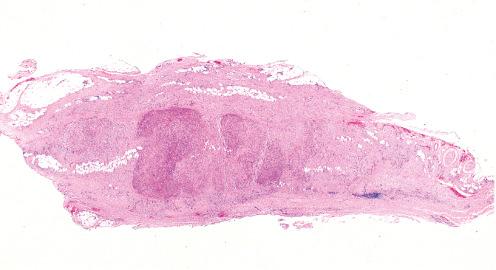
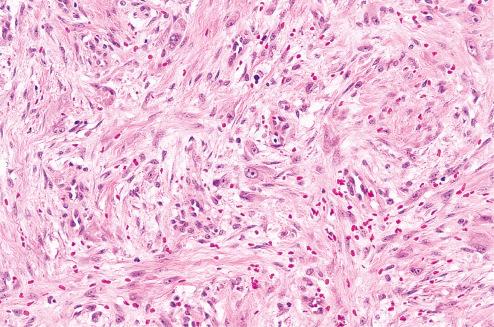
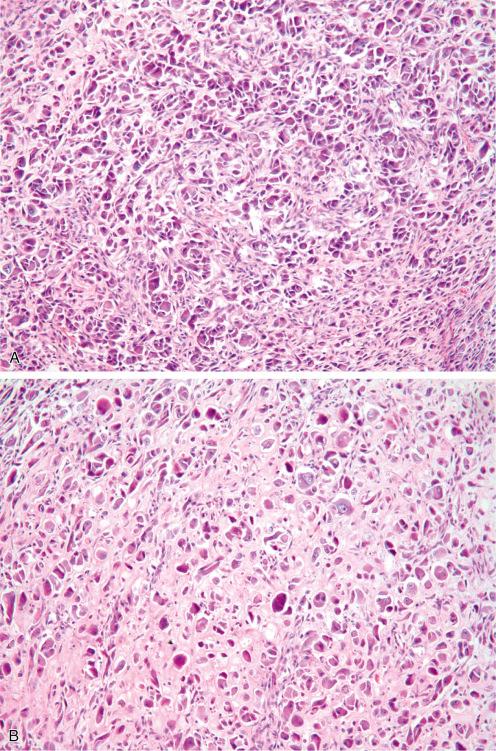
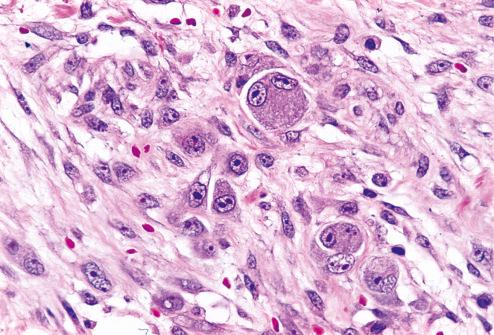
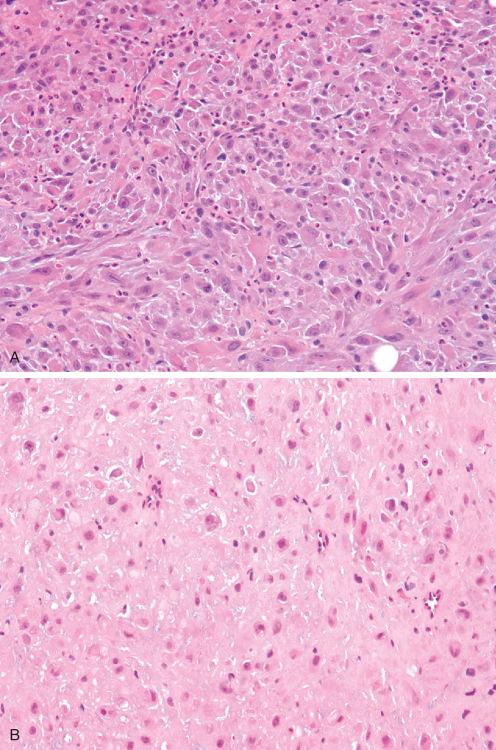
The immunohistochemical findings of proliferative fasciitis are similar to those of nodular fasciitis. The spindle and stellate-shaped cells stain for muscle-specific and smooth muscle actin. Some cells stain for CD68 (KP1); immunostains for keratins, S-100 protein, and desmin are usually negative. The ganglion-like cells may also stain for actin, although the staining is often focal and weak and may be membranous in distribution. SMARCB1 expression is retained, an important finding in highly cellular pediatric lesions where the differential diagnosis includes proximal-type epithelioid sarcoma and malignant rhabdoid tumor. Ultrastructurally, the spindle- and stellate-shaped cells have the typical features of fibroblasts and myofibroblasts. The ganglion-like cells are characterized by abundant RER with dilated cisternae, some of which may contain short-spacing collagen fibrils.
Proliferative myositis is the intramuscular counterpart of proliferative fasciitis. Although Kern is credited with the original description of proliferative myositis, Ackerman probably reported the first cases in his study of extraosseous nonneoplastic localized bone- and cartilage-forming lesions. Like proliferative fasciitis, proliferative myositis is a rapidly growing lesion that infiltrates muscle tissue in a diffuse manner and is characterized by bizarre giant cells closely resembling ganglion cells.
The symptoms are nonspecific, and the diagnosis of proliferative myositis always rests on histologic examination. In most cases the lesion is first noted as a palpable, more or less discrete, solitary nodular mass that measures 1 to 6 cm in diameter. It rarely causes tenderness or pain, even though it may double in size within a few days. The duration between onset and excision is usually less than 3 weeks.
Patients with proliferative myositis tend to be older than those with nodular fasciitis, with a median age of 50 years, although rare cases have been described in children. There seems to be no predilection for either gender or any particular race. The lesion mainly affects the flat muscles of the trunk and shoulder girdle, especially the pectoralis, latissimus dorsi, and serratus anterior muscles. Occasionally, tumors are also found in the muscles of the thigh. Involvement of the head and neck is uncommon.
Similar to proliferative fasciitis, proliferative myositis typically appears pale gray or scarlike, resulting in induration of the involved skeletal muscle ( Fig. 7.23 ). When present in small or flat muscles, it often replaces most or all of the involved musculature. When involving large muscles, there is preferential involvement of the skeletal muscle immediately underneath the fascia, with a progressive decrease in the central portion of the muscle in a wedgelike manner.
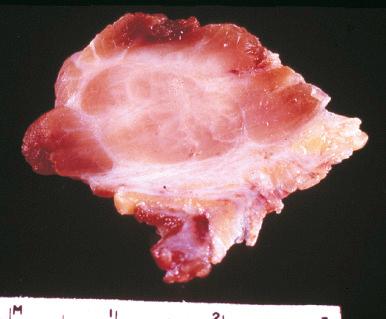
The cellular components of proliferative myositis are identical to those found in proliferative fasciitis. There is a poorly demarcated proliferation of fibroblast-like cells that involve the epimysium, perimysium, and endomysium. Unlike the intramuscular form of nodular fasciitis and musculoaponeurotic fibromatosis, this cellular proliferation rarely completely replaces large areas of the involved muscle and, rather, is most striking in the subfascial region and interfascicular connective tissue septa. The skeletal muscle fibers are relatively unaffected except for the presence of secondary atrophy, with neither sarcolemmal proliferation nor any evidence of skeletal muscle regeneration. This alternation of proliferating fibrous tissue with persistent atrophic skeletal muscle fibers results in a typical “checkerboard pattern” that is apparent at low magnification ( Fig. 7.24 ). The other conspicuous histologic feature of proliferative myositis of course is the presence of large, basophilic ganglion-like cells, identical to those found in proliferative fasciitis ( Figs. 7.25 and 7.26 ). Mitotic figures are often easily identified in both the spindle and the giant cells, although atypical mitoses are not seen. Rare lesions contain foci of metaplastic bone ( Fig. 7.27 ). The immunohistochemical and ultrastructural features of proliferative myositis are identical to those of proliferative fasciitis ( Fig. 7.28 ).
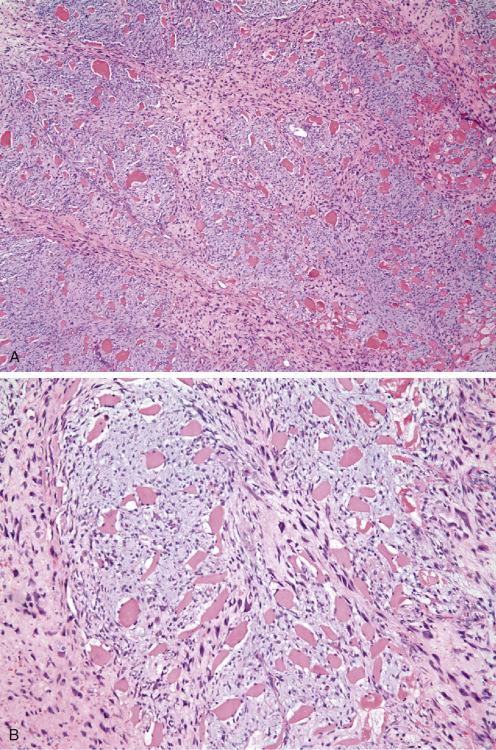
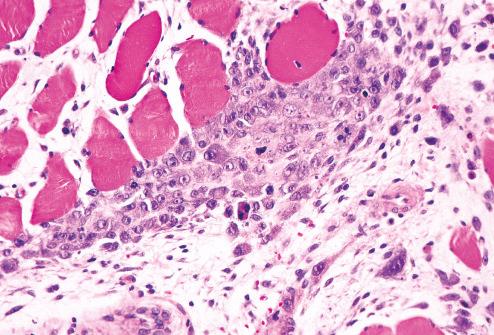
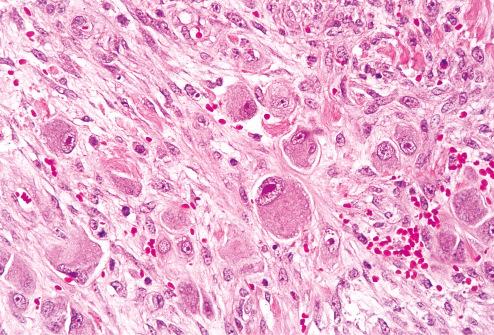
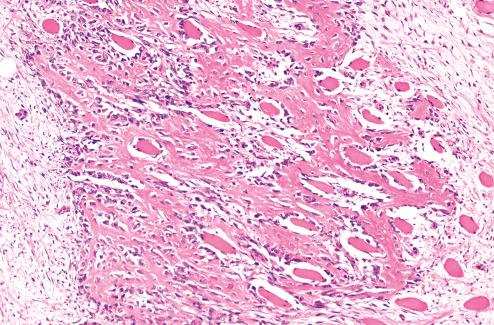
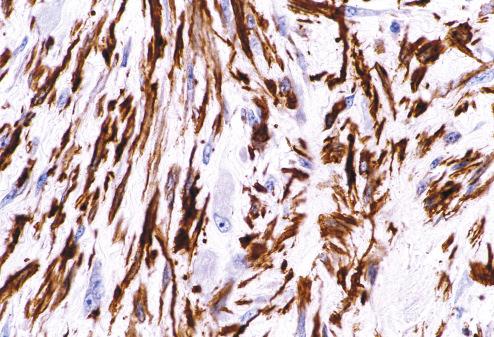
Proliferative fasciitis and myositis may be mistaken for a variety of malignant neoplasms, most commonly rhabdomyosarcoma or ganglioneuroblastoma . In the series of 53 cases of proliferative fasciitis by Chung and Enzinger, 16 were originally diagnosed as a sarcoma. Similarly, 14 of 33 cases of proliferative myositis reported by Enzinger and Dulcey were believed to be some type of sarcoma. Errors are most likely to occur with childhood cases in which rhabdomyosarcoma, epithelioid sarcoma, and malignant extrarenal rhabdoid tumor are strong diagnostic considerations. Histologically, the ganglion-like cells lack cross-striations and show more cytoplasmic basophilia than seen in rhabdomyoblasts. Although the IHC profiles may overlap, stains for desmin, MyoD1, and myogenin are negative in the ganglion-like cells, in contrast to the staining found in true rhabdomyoblasts. The absence of keratin expression and retained SMARCB1 expression excludes epithelioid sarcoma and malignant extrarenal rhabdoid tumor.
Proliferative fasciitis and myositis, like nodular fasciitis, are self-limiting, benign processes that are probably preceded by some type of fascial or muscular injury resulting in a proliferation of myofibroblasts. However, only a small number of patients report a preceding injury in the exact location of the lesion, suggesting that causes other than mechanical trauma play a role in the development of proliferative fasciitis and myositis. Although some have reported the diagnosis of these lesions by fine-needle aspiration cytology, the unusual histologic features of these lesions warrant caution with this technique. Both proliferative fasciitis and myositis are adequately treated by local excision, and recurrence is exceedingly rare. As with some cases of nodular fasciitis, spontaneous resolution in 1 to 16 weeks has been observed in patients with proliferative fasciitis and myositis. To our knowledge, aberrations of USP6 have not been found in proliferative fasciitis/myositis, although only a small number of cases have been evaluated. Trisomy 2 has been found in one case of each, and another case of proliferative myositis was found to harbor a t(6;14).
Organ-associated pseudosarcomatous myofibroblastic proliferations, most of which arise in the genitourinary tract, have been described under an impressive variety of names, including inflammatory pseudotumor, pseudosarcomatous myofibroblastic tumor, pseudosarcomatous myofibroblastic proliferation , pseudosarcomatous fibromyxoid tumor, and even nodular fasciitis. Most often, those arising as a result of preceding trauma or surgical instrumentation have been referred to as postoperative spindle cell nodule , whereas those arising spontaneously are often called inflammatory pseudotumor . Certainly, the vast array of names used to describe these proliferations has contributed to some of this confusion. However, the major controversy has focused on whether these lesions are reactive or neoplastic, including whether they are best designated as inflammatory myofibroblastic tumor , a term that implies a neoplastic process characterized by alterations of the anaplastic lymphoma kinase ( ALK) gene on 2p23. Several studies demonstrating ALK rearrangement and immunostaining for the ALK protein suggest that these lesions are neoplastic, although the two studies differ as to whether the lesions are believed to be identical to inflammatory myofibroblastic tumor. Harik et al. considered these lesions to be neoplastic, but distinct from an inflammatory myofibroblastic tumor, and favored the term pseudosarcomatous myofibroblastic proliferation , whereas the other group recommended calling them inflammatory myofibroblastic tumor . Clearly, however, no histologic difference exists between lesions harboring ALK abnormalities and those that do not. Likewise, no significant histologic differences exist between lesions that arise spontaneously and those that arise following instrumentation.
Although these lesions can arise anywhere in the genitourinary tract, including the prostate, vagina, urethra, and ureter, they are most common in the urinary bladder. For example, in the Hirsch study, 21 of 27 pseudosarcomatous myofibroblastic proliferations of the genitourinary tract arose in the urinary bladder. Similarly, 42 of 46 “inflammatory myofibroblastic tumors” arose in the urinary bladder. Most frequently, patients present with hematuria, although some have dysuria, abdominal pain, or weight loss. Based on the larger clinicopathologic studies, it is still unclear whether a gender predilection exists. In the Harik and Montgomery studies, males outnumbered females by a 2:1 or 3:1 ratio. However, Hirsch et al. found exactly the opposite: women were affected three times more often than men. Although the age range is broad, lesions usually arise in the fourth to fifth decade of life. Up to 20% to 25% of patients have a history of antecedent trauma or surgical instrumentation; lesions that arise secondary to surgical instrumentation usually become clinically apparent between 5 and 12 weeks after the procedure.
Grossly, most lesions present as exophytic, nodular, or polypoid intraluminal lesions that may extend deeply into the visceral organ from which they arise. They range in size from 1.5 cm to up to 12 cm, although most are between 3 and 5 cm at excision. The lesion may be firm or soft, depending on the relative amounts of fibrous and myxoid stroma present.
On microscopic examination, these lesions are characterized by a proliferation of spindle- to stellate-shaped cells, often with a tissue culture–like appearance reminiscent of nodular fasciitis ( Figs. 7.29 to 7.31 ). The cells lack cytologic atypia or nuclear hyperchromasia and have bipolar or stellate-shaped cytoplasmic processes. Typically, the cells are widely separated and haphazardly distributed in a myxoid stroma, although some cases are characterized by more cellular areas in which the cells are arranged in irregular fascicles with variable amounts of intercellular collagen. The cells have oval- to spindle-shaped nuclei with open chromatin, variably sized nucleoli, and eosinophilic to amphophilic cytoplasm. Mitotic figures are present, usually fewer than one or two per 10 high-power fields (hpf) and are not atypical. In the more myxoid zones, there is a prominent capillary network often associated with extravasated erythrocytes. A mixed inflammatory infiltrate composed of lymphocytes, plasma cells, eosinophils, and occasional mast cells is usually conspicuous. When present, neutrophils are associated with areas of mucosal ulceration.
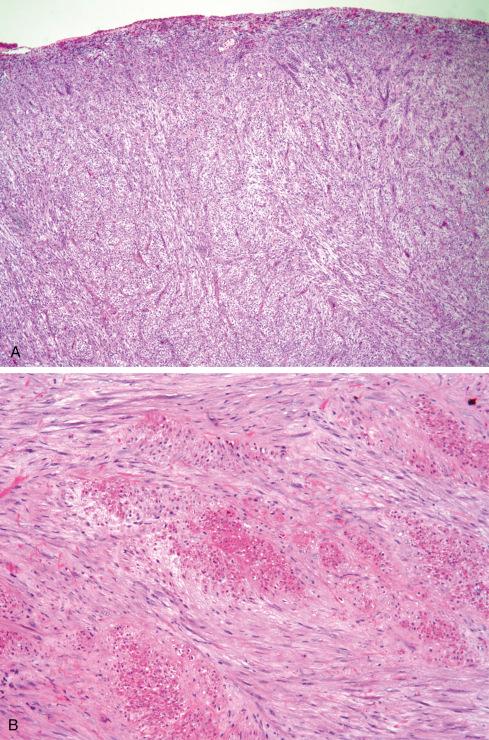
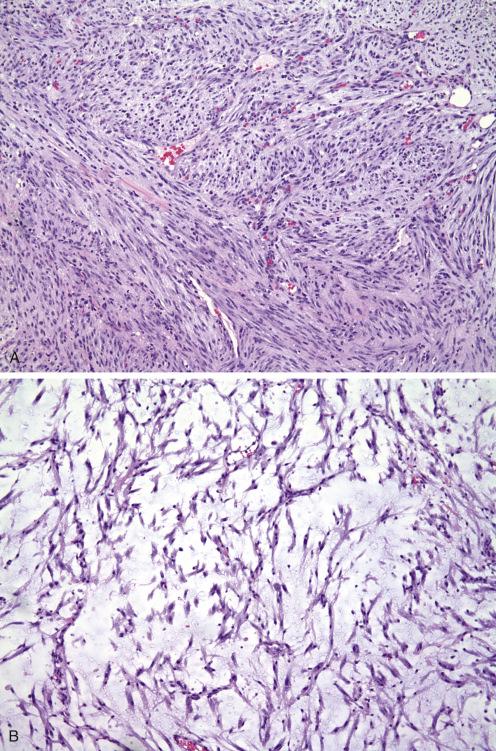
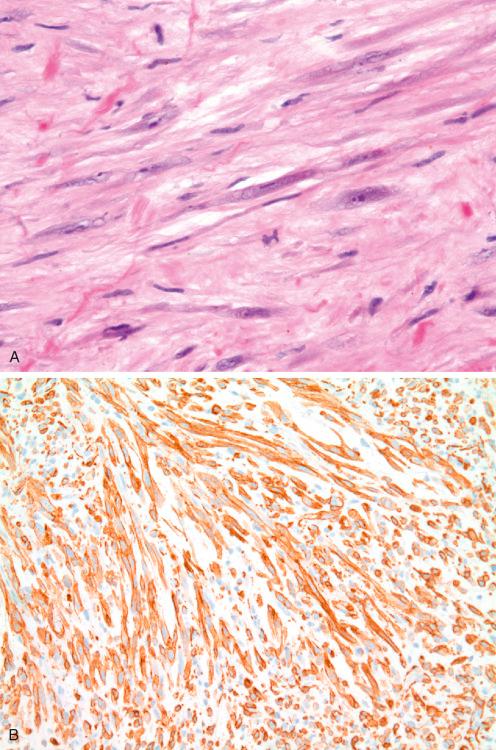
Some cases have histologic features that cause great concern for a malignancy, including a brisk mitotic rate, with up to 20 mitotic figures per 10 hpf. Invasion into the muscularis propria of the urinary bladder is a common finding, and some even infiltrate into the perivesicular adipose tissue. Although necrosis is usually focal and confined to the surface of the lesion and associated with mucosal ulceration, some cases show necrosis of the deeper tissue.
On IHC the spindle cells stain strongly for muscle markers, including muscle-specific actin, smooth muscle actin, and desmin. In addition, many cases show focal or even diffuse staining for keratins (see Fig. 7.31C ), which obviously can lead to diagnostic confusion. Harik et al. found that 31 of 35 cases stained for keratins, and Montgomery et al. found 25 of 34 cases (73%) to stain with the AE1/AE3 antibody, including 23 cases with strong, diffuse immunoreactivity. Many cases also stained for CAM 5.2 and keratin 18.
A significant percentage of these lesions also stains for ALK ( Fig. 7.31D ), but there is an imperfect correlation between ALK immunoreactivity and the detection of an ALK gene rearrangement by fluorescence in situ hybridization (FISH) ( Table 7.2 ). In the Harik study, 12 of 26 (46%) cases stained for this antigen, and FISH confirmed ALK rearrangement in four of six (67%) ALK-positive tumors. In the Montgomery study, 20 of 35 cases (57%) stained for ALK, and 13 of 18 ALK-positive cases (72%) showed evidence of an ALK alteration by FISH. In contrast, of the six ALK-immunoreactive cases evaluated by Hirsch et al., none showed evidence of an ALK gene translocation by FISH. Sukov et al. found ALK rearrangements in 14 of 21 cases (67%), with ALK staining in 13 of 21 (62%). All cases immunoreactive for ALK harbored ALK rearrangements; one ALK-negative case exhibited an ALK rearrangement. All other lesions studied (leiomyosarcomas, sarcomatoid carcinomas, embryonal rhabdomyosarcomas, and clearly reactive lesions) were negative for ALK rearrangement and ALK staining. For those cases with ALK fusions, a number of fusion partners have been identified, including HNRNPA1 and FN1 .
| Study | ALK Staining | ALK Gene Rearrangements (FISH) |
|---|---|---|
| Tsuzuki et al. | 12/16 | — |
| Hirsch et al. | 10/21 | 0/6 ∗ |
| Harik et al. | 12/26 | 4/10 † |
| Montgomery et al. | 20/35 | 13/18 |
| total | 52/96 (54%) | 17/34 (50%) |
∗ All six cases tested stained for ALK.
† Includes four ALK-negative cases (0/4) and six ALK-positive cases (4/6).
Although a pseudosarcomatous myofibroblastic proliferation should be suspected when one encounters a spindle cell lesion in the genitourinary tract, particularly in a patient who has undergone recent instrumentation at that site, numerous other benign and malignant spindle cell proliferations must be considered ( Table 7.3 ). Myxoid leiomyosarcoma tends to occur in older patients and is rare before age 20. Microscopically, the lesion is composed of spindle cells with densely eosinophilic fibrillar cytoplasm, often with perinuclear vacuoles, deposited in a myxoid stroma. These lesions can also express keratins, but they do not stain for ALK. Pseudosarcomatous myofibroblastic proliferations are characterized by a more prominent vasculature, variable cellularity, and a more conspicuous inflammatory component. Moreover, these lesions characteristically have a zonal quality consisting of superficial (submucosal) myxoid zones juxtaposed to deep cellular zones associated with a prominent arcuate vascular pattern.
| Feature | PMP | ML | B-RMS | SC |
|---|---|---|---|---|
| Cellularity | + | +/++ | +/++ | ++ |
| Growth pattern | Loose | Loose | Botryoid | Biphasic |
| Atypia | + | +/++ | ++ | +++ |
| Electron microscopy | Fibroblast/myofibroblast | Smooth muscle | Striated muscle | Epithelial |
| Cytokeratin | Frequent + | Rare | − | + |
| Desmin | ± | + | + | ± |
| SMA | + | + | − | ± |
| ALK | 50% | − | − | − |
Botryoid-type rhabdomyosarcoma is also a diagnostic consideration; this lesion is characterized by a cambium layer under the epithelium composed of atypical, hyperchromatic cells, occasionally with overt rhabdomyoblastic differentiation. IHC (myogenin) analysis reveals evidence of skeletal muscle differentiation.
IHC detection of epithelial differentiation in many pseudosarcomatous myofibroblastic proliferations often raises concern for a sarcomatoid urothelial carcinoma . The presence of marked cytologic atypia, atypical mitotic figures, and nonmyxoid zones with greatly increased cellularity and identification of an in situ urothelial carcinoma are useful in recognizing sarcomatoid urothelial carcinoma. In addition, expression of ALK in pseudosarcomatous myofibroblastic proliferations is a useful finding in this differential diagnosis.
Whether organ-associated pseudosarcomatous myofibroblastic proliferations should be considered true neoplasms or exuberant reactive proliferations is controversial because evidence supports both points of view. The history of prior surgical instrumentation in up to 25% of patients and the bland myofibroblastic appearance of the constituent cells, in association with a myxoinflammatory background, are hallmarks of many reactive soft tissue processes. However, the majority of cases arise spontaneously without a history of prior surgical instrumentation. These lesions may show extensive mural growth, and some infiltrate even further into the surrounding soft tissue. From an immunophenotypic standpoint, these cases are rather unique when compared to other pseudosarcomatous myofibroblastic proliferations because most express keratins, sometimes diffusely.
Although there are conflicting data, as discussed above, some lesions clearly harbor rearrangements of the ALK gene. Some myofibroblastic proliferations of the genitourinary tract may be reactive, whereas others are truly ALK -related neoplasms. The consensus is that subtle differences allow one to distinguish these lesions from true inflammatory myofibroblastic tumor in most cases. The former have a relative paucity of plasma cells, a more prominent edematous stroma, and a lack of the peculiar ganglion-like cells of inflammatory myofibroblastic tumor. Also, pseudosarcomatous myofibroblastic proliferations and inflammatory myofibroblastic tumors may represent various points along a single spectrum, rather than representing two distinct entities.
Regardless of whether one considers these reactive or neoplastic, the vast majority of these genitourinary lesions follow a benign clinical course. Follow-up available in 28 patients with urinary bladder lesions revealed recurrences in only three patients, and none developed metastatic disease. In the Hirsch study, 3 of 17 patients developed nondestructive recurrences 3 months to 108 months after initial excision. Montgomery et al. found a higher rate of local recurrence; 10 of 32 patients with clinical follow-up developed local recurrence at a mean of 3 months following initial excision. These authors found no association between the risk of local recurrence and histologic features or the presence or absence of ALK gene abnormalities. However, one of the cases in this study, a tumor involving the prostatic urethra and urinary bladder, showed features consistent with a malignant inflammatory myofibroblastic tumor. This patient had a rapid recurrence of his tumor and died with intraabdominal metastatic disease at 9 months, despite being treated aggressively with chemotherapy.
Ischemic fasciitis and atypical decubital fibroplasia are synonyms for a pseudosarcomatous fibroblastic/myofibroblastic proliferation that predominantly involves soft tissues overlying bony prominences and that often occurs in elderly and physically debilitated or immobilized patients. Most patients are elderly, with a peak incidence during the eighth and ninth decades of life, although this lesion has rarely been described in adolescents ( Table 7.4 ). Although data are conflicting, Liegl and Fletcher showed a male predilection (15 women, 29 men). Most patients present with a painless mass of short duration, usually less than 6 months; many patients are debilitated or immobilized, bedridden, or wheelchair-bound. Only 7 of 44 patients were debilitated, although 9 patients had a history of chronic or malignant disease, and 4 other patients had a history of local trauma to the affected site. The soft tissues in the region of the shoulder are most frequently affected, followed by the soft tissues of the chest wall overlying the ribs and those overlying the sacrococcygeal region or greater trochanter.
| Series | Year | Male/Female Ratio | Age Range | Recurrence |
|---|---|---|---|---|
| Perosio et al. | 1993 | 2/4 | 37-87 (median: 76) | 1/5 (20%) |
| Montgomery et al. | 1992 | 12/16 | 15-95 (median: 78) | 3/21 (14%) |
| Liegl et al. | 2008 | 29/15 | 23-96 (median: 74) | 1/13 (8%) |
Grossly, ischemic fasciitis tends to be poorly circumscribed and vaguely multinodular, often with a myxoid quality; it ranges from 1 to 10 cm in greatest diameter, with a medium size of about 5 cm. It typically involves the subcutaneous tissue but may extend into the overlying dermis, with infrequent epidermal ulceration. In addition, the proliferation can involve the underlying skeletal muscles or adjacent periosteum.
On microscopy, ischemic fasciitis has a distinct zonal pattern, best appreciated at low magnification, often with a central zone of liquefactive or focally coagulative necrosis surrounded by a fringe of proliferating vessels and fibroblasts/myofibroblasts ( Figs. 7.32 and 7.33 ). The peripheral vessels are usually small, thin walled, and ectatic; they are lined by prominent, occasionally atypical endothelial cells ( Fig. 7.34 ). In addition, a proliferation of plump cells form perivascular clusters or merge imperceptibly with the peripheral vessels; these cells may be cytologically atypical, with large, eccentric, often smudgy hyperchromatic nuclei, prominent nucleoli, and abundant basophilic cytoplasm. Some resemble the ganglion-like cells seen in proliferative fasciitis or myositis. The proliferation is usually paucicellular; although mitotic figures may be numerous, they are not atypical. The peripheral vessels may contain fibrin thrombi and secondary acute inflammation with perivascular hyalinization. Multivacuolated muciphages can be seen in the myxoid zones and may mimic the lipoblasts of myxoid liposarcoma.
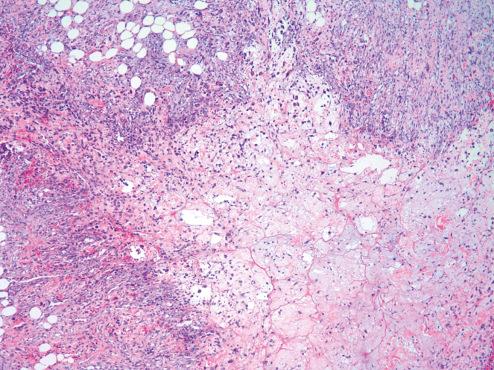
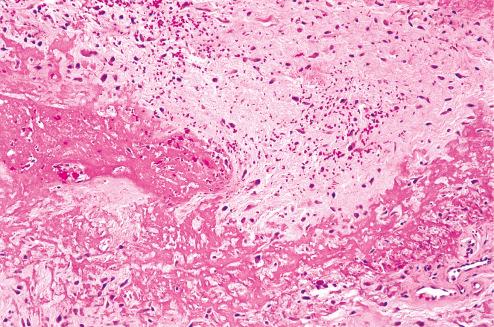
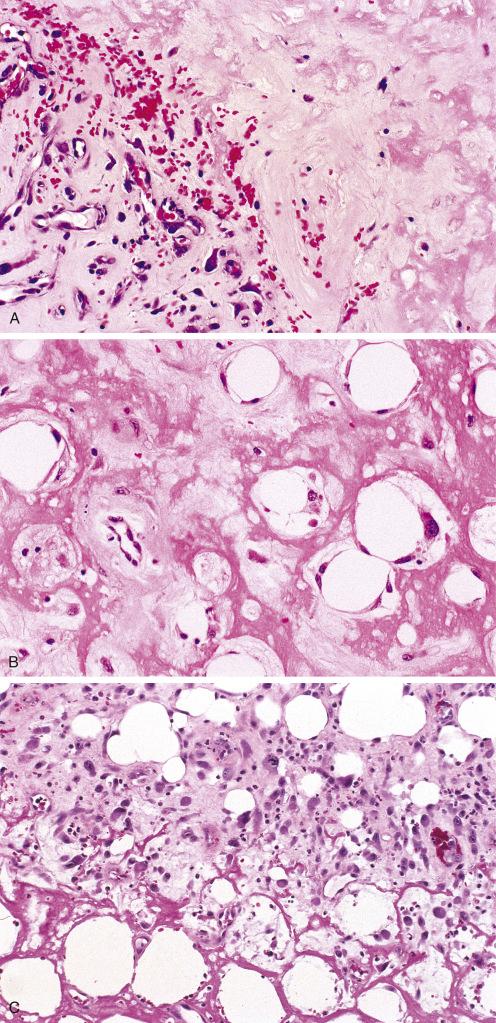
On IHC the atypical fibroblast-like cells often stain for actin, desmin, or both markers, whereas stains for S-100 protein and keratins are consistently negative. Unlike nodular fasciitis, aberrations of USP6 have not been documented in ischemic fasciitis.
In more than one-third of reported cases of ischemic fasciitis, a malignant diagnosis is seriously considered. Although the multinodular appearance with central necrosis is reminiscent of epithelioid sarcoma , the latter typically occurs on the distal extremity of young patients and is composed of cells with prominent cytoplasmic eosinophilia and keratin immunoreactivity with loss of SMARCB1 expression. Myxoid liposarcoma is also a consideration, but ischemic fasciitis lacks the organized plexiform vasculature typical of myxoid liposarcoma. Furthermore, although multivacuolated muciphages may be seen, true lipoblasts are not identified. Myxofibrosarcoma lacks the zonation of ischemic fasciitis and the degenerative and reactive features, such as cells with smudgy chromatin, fat necrosis, hemosiderin deposition, and fibrin thrombi.
Ischemic fasciitis, at least those cases associated with immobility, is probably related to intermittent soft tissue ischemia with subsequent tissue breakdown and regenerative changes. Most lesions develop in areas where the subcutaneous tissue lies in close apposition to bone. Histologically, the zonal quality is similar to that seen in other reactive fibroblastic and myofibroblastic proliferations. The pathogenesis is probably similar to that of a decubitus ulcer, except that the ischemia may be less severe or of an intermittent nature and does not lead to breakdown of the overlying skin. However, alternative mechanisms likely also play a role because not all cases are associated with debilitation or immobility. Although local recurrences have been described (presumably related to incomplete excision and regrowth caused by the underlying ischemic process), most patients are cured by conservative excision, supporting its benign nature. Awareness of this entity should allow the pathologist to avert a misdiagnosis of sarcoma and guide the clinical measures necessary to prevent subsequent recurrence or progression.
Fibroma of tendon sheath is a slowly growing, dense, fibrous nodule that is firmly attached to the tendon sheath and is found most frequently in the hands and feet. Its lobular configuration resembles that of a tenosynovial giant cell tumor, but it is much less cellular and lacks the polymorphic features of the latter lesion.
Fibroma of tendon sheath is usually small (<2 cm), typically has been present for some time, and has increased slowly in size, often over many years. It is found most often in adults 20 to 50 years of age and is more than twice as common in men as in women. Almost all these tumors arise in the extremities; the upper extremity is more often affected than the lower extremity. The most common sites of involvement in the upper extremity are the fingers (especially the thumb, index, and middle fingers), hand, and wrist, with only rare involvement of the forearm, elbow, or upper arm. Sites of involvement in the lower extremity are the knee, foot, ankle, and rarely the toe or leg. Some cases arise as an intraarticular mass that can restrict the normal range of motion. As many as one-third of patients have slight tenderness, pain, or limited range of motion of the affected digit. A history of antecedent trauma has been reported in the minority (<10%) of patients.
Most lesions are well circumscribed and have a lobular configuration, similar to that of a tenosynovial giant cell tumor. Actual attachment to a tendon or tendon sheath is visible in most but not all cases. On cut section, the lesions are usually uniform in appearance with a gray or pearly white color. Occasionally, grossly myxoid and cystic areas are seen.
Microscopically, the lesion appears well circumscribed and lobulated or multilobulated and is composed of spindle-shaped cells resembling fibroblasts with elongated nuclei, fine chromatin, and small basophilic nucleoli. Most lesions lack cytologic atypia, although striking nuclear pleomorphism has been described (so-called pleomorphic fibroma of tendon sheath). In these unusual cases, the mitotic index is not commensurate with the degree of nuclear pleomorphism, suggesting a degenerative phenomenon. Stellate-shaped cells may also be present, particularly in myxoid zones. Most lesions are hypocellular, with widely spaced cytologically bland cells deposited in a densely eosinophilic hyalinized collagenous stroma. However, some have zones of increased cellularity in which the cells are arranged in either a storiform or fascicular growth pattern closely resembling nodular fasciitis ( Figs. 7.35 and 7.36 ). These cellular areas always blend with less cellular collagenous areas. As discussed next, data suggest such lesions simply could be examples of nodular fasciitis involving the distal extremities. In some cases, small myxoid zones are interspersed between the densely collagenized zones. A characteristic feature is the presence of elongated cleftlike spaces lined by flattened cells, particularly at the periphery of the lobules. Some lesions contain multinucleated giant cells, but xanthoma cells and hemosiderin deposits are not present. Osteocartilaginous metaplasia may be seen but is not common.
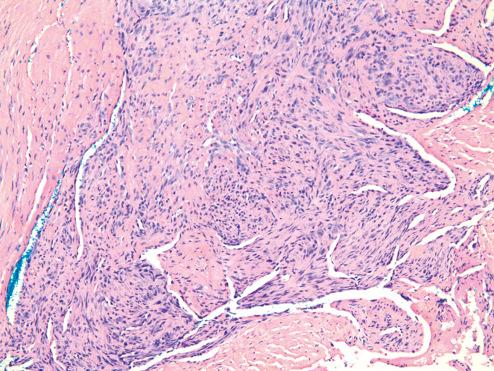
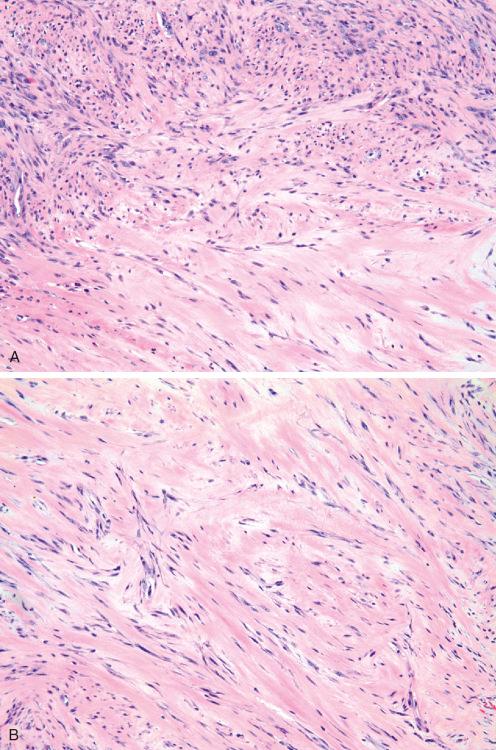
The lesional cells express muscle markers, including muscle-specific and smooth muscle actin without staining for desmin. It has been proposed that fibroma and tenosynovial giant cell tumor represent histogenetically related lesions that are at the extremes in a spectrum of histiocytic-fibroblastic-myofibroblastic differentiation, but this is doubtful given that these tumors do not contain areas resembling a giant cell tumor. Tenosynovial giant cell tumors are also now known to be neoplasms of CSF1 -rearranged synoviocytes (see Chapter 25 ). Fibromas of tendon sheath do not express clusterin, a marker expressed by the neoplastic synoviocytes of tenosynovial giant cell tumor.
The typical fibroma of tendon sheath, composed of a hypocellular proliferation of bland spindle cells deposited in a densely collagenized stroma, is characteristic and unlikely to be confused with other entities. Lesions that show more cellular zones may be confused with fibrous histiocytoma or nodular fasciitis. Pulitzer et al. reported that up to one-fourth of their cases had areas that were indistinguishable from nodular fasciitis (see later). Translocations involving the long arm of chromosome 2 have been described in fibroma of tendon sheath (t[2;11][q31-32;q12]) and in several cases of collagenous fibroma (also known as desmoplastic fibroblastoma), suggesting a link between these entities. However, FOSL1, an antigen characteristically expressed in collagenous fibroma, is uniformly absent in cases of fibroma of tendon sheath. Tenosynovial giant cell tumors are morphologically quite different from fibromas of tendon sheath, consisting of a polymorphous population of small histiocytes, larger clusterin-positive synoviocytes containing CSF1 aberrations, osteoclast-like giant cells, and foamy macrophages.
Rare fibromas of tendon sheath show striking nuclear pleomorphism and may be confused with a pleomorphic sarcoma . However, the latter is characterized by greater cellularity and mitotic activity, including atypical mitoses, as well as a more pronounced storiform growth pattern. Finally, simply based on location, one could consider myxoinflammatory fibroblastic sarcoma (also known as inflammatory myxohyaline tumor ), but this entity is characterized by an intimate admixture of inflammatory, myxoid, and hyalinized zones as well as bizarre cells resembling Reed-Sternberg cells or cytomegalovirus-infected cells.
Become a Clinical Tree membership for Full access and enjoy Unlimited articles
If you are a member. Log in here